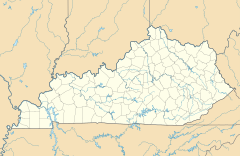Kentucky State Reformatory
| Location | 3001 W Hwy 146, LaGrange, Kentucky |
|---|---|
| Coordinates | 38°24′13″N 85°24′57″W / 38.40361°N 85.41583°WCoordinates: 38°24′13″N 85°24′57″W / 38.40361°N 85.41583°W |
| Status | open |
| Security class | medium |
| Capacity | 1998 |
| Opened | 1936 |
| Managed by | Kentucky Department of Corrections |
Kentucky State Reformatory is a medium-security prison for adult males. The prison is located in unincorporated Oldham County, Kentucky, near La Grange, and about 30 miles (48 km) northeast of Louisville. It was established in 1936 to replace the Kentucky State Reformatory located in Frankfort after a flood damaged the original property [3]. The 43-acre (170,000 m2) facility has the capacity to house 1,998 inmates, thus making it the largest prison in the state.
The original Kentucky State Penitentiary was built in Frankfort in 1798. In 1879, a branch penitentiary was built in Eddyville. In 1912, the prison in Eddyville was renamed the Kentucky State Penitentiary. The remaining structure in Frankfort was renamed the Kentucky State Reformatory. Reformatories typically house younger, first-time offenders and offer programs that are intended to rehabilitate inmates after they are released. Despite the implications of the name change, the Kentucky State Reformatory continued to incarcerate inmates of all ages.
The original cell house in Frankfort contained 648 single-occupancy cells measuring only 7 by 3.1 by 7 feet (2.13 by 0.94 by 2.13 m) on six tiers. In the 1870s, a second cell house was built. This cell house contained 408 cells that were slightly larger than those in the original cell house, measuring 7 by 4.1 by 7 feet (2.1 by 1.2 by 2.1 m). These larger rooms contained a double-deck bunk for two inmates. None of the cells had plumbing. By the 1920s, three dormitories had been built. Two of these dormitories were reserved for white inmates and one was reserved for black inmates. Two of the dormitories contained 152 cells and the third contained 100.
The prison in Frankfort housed a small population of female inmates. They lived alongside the prison in a separate cell house. In 1928, female inmates numbered 85. By the end of the 1920s, there were only 70 Correctional Officers watching 1,649 inmates. These Correctional Officers worked seven days a week, eight hours a day and only received two weeks of vacation.
Inmates at the Kentucky State Reformatory labored in workshops during the day. The Reformatory had contracts with the Gordon Shirt Company, the Frankfort Chair Company, the Hoge Montgomery Shoe Company and the Frankfort Broom Company. The Kentucky State Reformatory paid inmates between 5 and 20 cents per day. All of the industries were under the contract system in which the prison leased the labor of inmates to private industries. Inmates worked in the prison workshops making products for these private industries. Prisons that used the contract system often made a great deal of revenue from the system. The system was also profitable for the private industries. Inmate labor was always abundant and available, the labor was cheap and prisoners could not form unions or misbehave. Because the workshops were located in the prison, private industries did not have to pay rent.
...
Wikipedia

